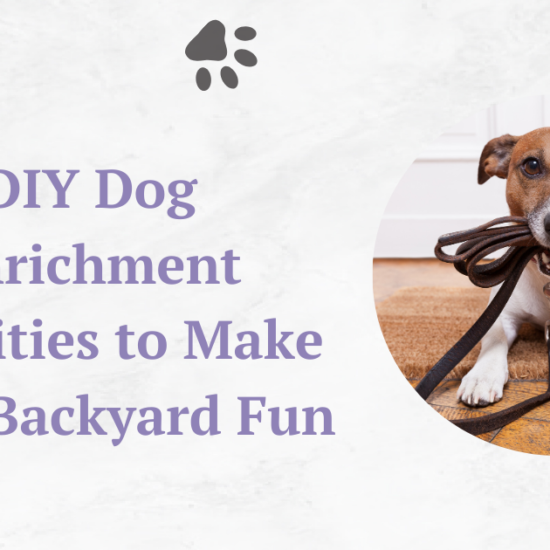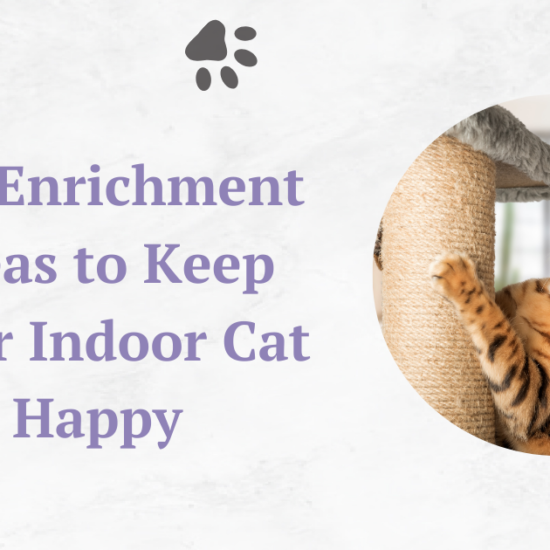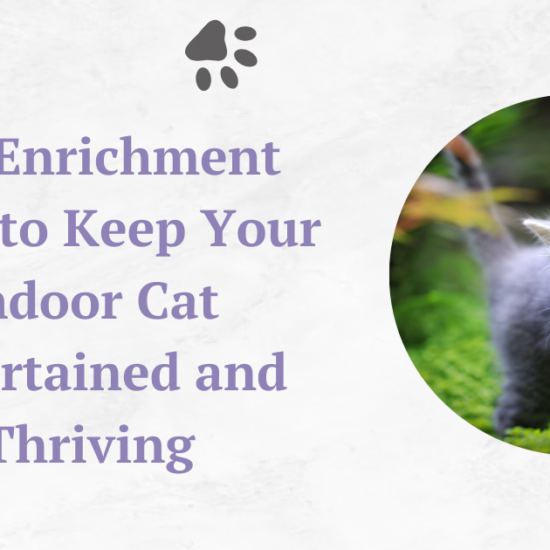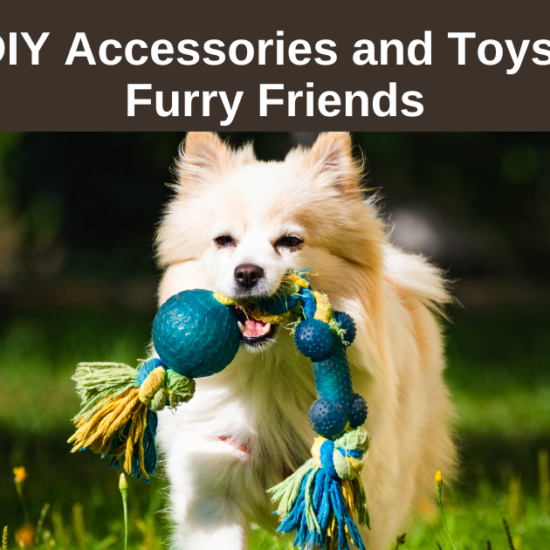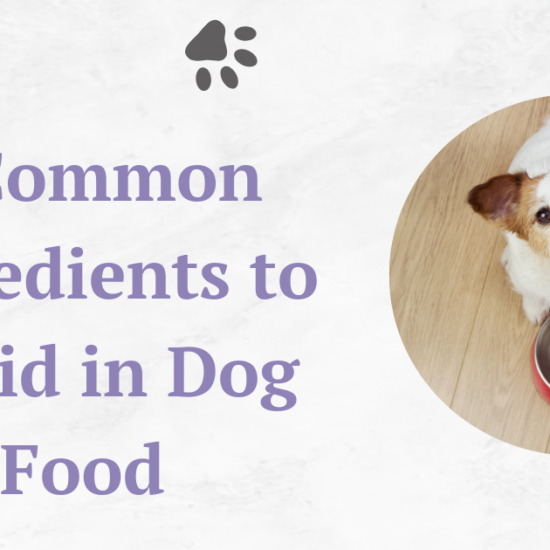Many people’s love for dogs is strong, but sadly, so are their allergies. Allergic responses to dog dander can be a substantial barrier to having a furry buddy in their lives. There is some good news for allergy sufferers: hypoallergenic dog breeds. These breeds have been specially bred to produce fewer allergenic particles, making them a possible answer for allergy sufferers.
Table of Contents
Introduction
In this detailed article, we will delve into the world of hypoallergenic dog breeds, refute myths, provide a list of top hypoallergenic dogs, and offer recommendations on how to efficiently manage allergies.
Overview of Allergies from Dogs
Let’s have an overview of allergies and dog dander.

What are the causes of allergic reactions?
Allergies are a prevalent problem that affects millions of individuals throughout the world. They develop when the immune system overreacts to normally harmless particles such as pollen, dust mites, or specific proteins present in animal dander, particularly dog dander. When an allergic person is exposed to these allergens, their immune system recognizes them as threats and releases substances such as histamine, resulting in a variety of allergy symptoms.
Proteins present in dog dander, saliva, and urine are the main causes of dog allergies. Dog dander is the skin flakes that dogs naturally shed. It contains allergenic proteins that can cause allergic reactions in people who are susceptible to them. These proteins can linger in the air for long periods of time, making them easily breathed in or coming into contact with environmental surfaces.
The Function of Dog Dander
For dog allergy sufferers, dog dandruff is a significant source of allergens. Dogs shed small skin particles containing allergenic proteins as they move and scratch. These particles can readily get airborne and land on surfaces such as furniture, carpets, and bedding throughout the home. Even when there is no dog around, allergenic proteins in dander can linger for a long time, causing continued allergic reactions in susceptible individuals.
The Effects of Allergies on Individuals
Dog dander allergies can cause a variety of symptoms, both minor and severe. The severity of the symptoms varies according to the individual’s sensitivity and level of allergen exposure. Common dog allergy symptoms include:
- Sneezing: When exposed to dog allergens, allergic people may experience frequent and persistent sneezing.
- Nasal congestion: Dog allergens can cause a stuffy or runny nose, making breathing difficult.
- Itchy and watery eyes: Exposure to dog allergens can cause itching, redness, and excessive tears.
- Itchy rashes or hives on the skin: Direct contact with dog dander or saliva can cause itchy rashes or hives on the skin.
- Coughing and wheezing: When exposed to dog allergens, some people may experience coughing and wheezing, which are comparable to asthma symptoms.
- Chest tightness and difficulty breathing: Severe allergic responses can cause difficulty breathing, shortness of breath, and chest tightness.
- Weariness and sleep disturbances: Allergy symptoms can disrupt sleep, creating weariness and drowsiness during the day.
- Headaches: As a result of allergic reactions to dog allergens, some people may have headaches.
It is crucial to note that these symptoms might differ from person to person and may appear immediately or develop over time after being exposed to dog allergies.
Debunking Hypoallergenic Dog Myths
Here we are going to present some crucial insights for debunking hypoallergenic dog myths. These insights will help you choose the best hypoallergenic dogs.

Dog Breeds That Are Hypoallergenic
Individuals with allergies who want to have a dog without provoking their allergic reactions frequently seek out hypoallergenic dog breeds. While no dog breed is fully allergy-free, some of the top hypoallergenic dogs are intentionally designed to create fewer allergenic particles, making them possibly suitable for allergy sufferers. These breeds are distinguished by their hair-like coats rather than fur, which minimizes the quantity of dander they shed.
Debunking the Myth
One popular myth about hypoallergenic dogs is that they are fully allergy-free. This, however, is not totally correct. While hypoallergenic breeds create fewer allergens than other breeds, some allergenic particles are still produced. Individual allergic reactions can still occur, less frequently or intensely.
Individuals with allergies must recognize that even the top hypoallergenic dogs are not a cure-all for their allergic reactions. Allergies are caused by the immune system of the body reacting to certain allergens, and while hypoallergenic breeds may produce fewer allergic reactions, they cannot completely remove allergies. Individuals’ levels of allergenicity vary, and what causes a mild reaction in one person may induce a more severe reaction in another.
Allergic reactions require a multifaceted strategy that includes allergen avoidance measures, good grooming and hygiene practices, and, in some cases, medicinal interventions or immunotherapy. Individual responses to allergens vary, and other factors, such as breed, grooming practices, and the overall home environment, all play a role in effectively managing allergies.
Things to Think About When Choosing a Hypoallergenic Dog
Some of the major points you need to keep in consideration while choosing a hypoallergenic dog for your home
Individual Allergen Sensitivity
It is critical to understand your specific sensitivity to allergies before opting to bring a hypoallergenic dog into your household. Allergies differ greatly from person to person, and what causes allergic reactions in one person may not affect another to the same extent. Before making a decision, spend time with hypoallergenic breeds to assess personal reactions and determine compatibility between the individual and the dog.
Allergy testing and discussions with allergists can provide significant insights into specific allergens and their effects on an individual in some situations. Allergy tests can help pinpoint which allergens cause sensitivities, allowing people to make an informed decision about which hypoallergenic breed is best for them.
Grooming and Maintenance Requirements
Hypoallergenic dogs frequently require regular grooming to prevent matting and excessive dander shedding. Brushing the dog’s coat, bathing them on a regular basis using hypoallergenic shampoos, and, in certain circumstances, cutting their hair to keep it at a manageable length are all part of this grooming routine.
It is critical to consider the time and money required to maintain a hypoallergenic dog’s coat, especially for people with limited time. Some hypoallergenic breeds may require more regular grooming than others, and failing to meet their grooming demands might result in mats, which trap dander and aggravate allergy reactions.
Physical Activity and Space Requirements
Different hypoallergenic breeds have different exercise and space needs. Some breeds are more energetic and require more physical activity to flourish, whereas others require less. When selecting a hypoallergenic breed, it is critical to examine your lifestyle and living conditions.
If you enjoy outdoor activities and live an active lifestyle, a breed that requires more exercise and space may be a better fit. If you have limited space or live in an apartment, a breed with fewer activity requirements may be a better fit. Matching the demands of the dog to your lifestyle guarantees that you and the dog are both happy and pleased.
Personality and Compatibility
Hypoallergenic breeds, like all canines, have distinct temperaments and characteristics. It is critical to select a breed that corresponds to your lifestyle, energy level, and tastes. Some breeds are better suited to families with children, while others are better suited to individuals or couples. To pick the top hypoallergenic dogs that meet your individual needs, consider the breed’s normal temperament features, such as energy levels, sociability, and compatibility with other dogs.
Understanding and researching the breed’s traits will help you and your hypoallergenic dog have a pleasant connection. Furthermore, prior to making a decision, engaging with the breed or particular dogs of that breed can provide valuable information about their behavior and compatibility.
Allergy Testing and Consulting Experts
It is recommended to contact allergists and healthcare specialists before bringing a hypoallergenic dog into your home to identify the best course of action. Allergy testing will help you discover particular allergens that cause responses and aid you in selecting the best hypoallergenic breed for you.
Consulting professionals can offer individualized guidance based on your specific allergy profile and assist you in navigating the obstacles of living with a dog while effectively managing allergies. They can also provide advice on allergy management approaches, lifestyle changes, and, if necessary, medication therapies.
Well-known Hypoallergenic Dog Breeds
If you have allergies but still want a dog, try adopting one of the top hypoallergenic dogs. Hypoallergenic breeds are less likely to induce allergic reactions in those who are hypersensitive to allergens. Remember that no dog breed is 100% hypoallergenic, as all dogs create allergies. Hypoallergenic breeds, on the other hand, tend to produce fewer allergens or have hair that is less likely to trigger allergies. Here are some of the top hypoallergenic dogs to consider:

Bichon Frise
The Bichon Frise is a petite, happy dog with a hypoallergenic coat. Because these dogs have hair rather than fur, they shed less dander. To prevent matting and maintain the quality of their coat, they must be groomed on a regular basis. Bichon Frises are amiable, affectionate, and adapt well to a variety of living situations, making them perfect for both families and individuals.

Poodle
Poodles are available in three sizes: standard, miniature, and toy. Because of their curly, low-shedding hair, they are frequently recognized as one of the best small hypoallergenic dogs. Poodles are highly intelligent, and trainable, and make excellent family and individual companions. To keep its hypoallergenic features, its coat must be professionally groomed.
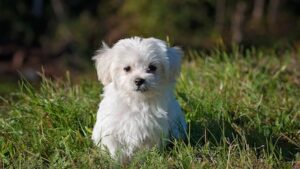
Maltese
Maltese dogs are petite and have a hypoallergenic coat that needs to be brushed on a regular basis to prevent matting. They are known for being lively and friendly, which makes them excellent companions for people or families with older children. Maltese dogs thrive on human connection and are adaptable to a variety of living settings.
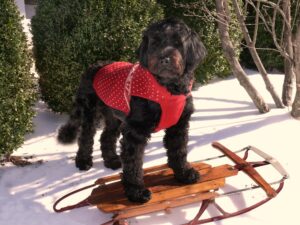
Portuguese Water Dog
The Portuguese Water Dog has a curly, hypoallergenic coat that must be groomed on a regular basis to prevent matting. They are lively, bright, and large hypoallergenic dogs well-known for their swimming prowess. Portuguese water dogs are ideal for energetic people and families who appreciate outdoor sports and water.
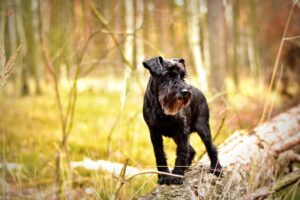
Schnauzer
Schnauzers are available in a variety of sizes, including tiny, standard, and gigantic. They have a wiry, hypoallergenic coat that must be groomed on a regular basis. Schnauzers are loyal, protective, adaptable, and big hypoallergenic dogs that are ideal for people or families seeking a flexible companion. They are distinguished by their unusually bearded muzzles and expressive eyes.
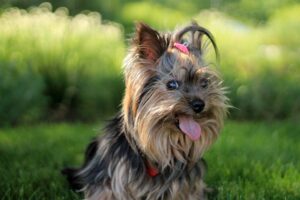
Yorkshire Terrier
Yorkshire Terriers, or “Yorkies,” one of the best small hypoallergenic dogs, have a long, hypoallergenic coat that needs to be brushed and groomed on a regular basis. They are petite, lively canines who make wonderful companions for singles or families with older children. Yorkshire Terriers, despite their small stature, are confident and have a vibrant demeanor.
Note: There might be affiliate links mentioned here. We may receive a commission if you purchase a product through an affiliate link. There is no additional charge for you. Please do your own research before making any online purchases.

Shih Tzu
Shih Tzus have a luxuriant, hypoallergenic coat that needs to be groomed on a regular basis to prevent tangles and matting. They are regarded as one of the best small hypoallergenic dogs, having affectionate and outgoing traits. They make excellent companions for people or families who live in apartments or small houses. Shih Tzus are noted for their outgoing personalities and striking facial traits.
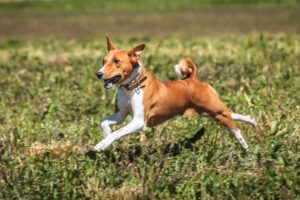
Basenji
Basenjis have a low-shedding, short coat that is hypoallergenic. They are little to medium-sized canines distinguished by their intellect, independence, and distinctive vocalizations. Basenjis are appropriate for people or families who enjoy an energetic and spirited breed.
Individual sensitivities to allergens can vary; therefore, it is critical to spend time with the exact breed or individual dogs within that breed before making a final selection. Furthermore, when living with a hypoallergenic dog, adequate grooming, allergen avoidance tactics, and regular cleaning of the living environment are vital for preventing allergic reactions.
Remember to seek the advice of a healthcare professional or allergist to examine your specific allergy profile and pick the best hypoallergenic breed for your personal needs.

West Highland White Terrier
The West Highland White Terrier, sometimes known as the Westie, is a tiny hypoallergenic breed distinguished by its white, low-shedding hair. They are considered one of the best small hypoallergenic dogs because they have a warm and outgoing disposition. They are excellent companions for both families and individuals. Westies must be groomed on a regular basis to keep their hypoallergenic coat.
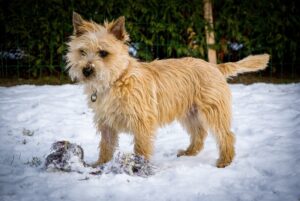
Cairn Terrier
Cairn Terriers are counted as one of the best small hypoallergenic dogs. These are lively dogs with a hypoallergenic coat that must be brushed on a regular basis. They are well-known for their intellect, devotion, and sense of humor. Cairn Terriers adapt well to a variety of living situations and make excellent companions for seniors or families with older children.
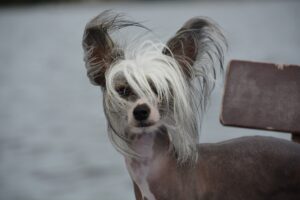
Chinese Crested
The Chinese Crested is a distinctive breed among the small dog breeds that is hypoallergenic and has two coat colors: hairless and powderpuff. Individuals with severe allergies prefer the hairless kind since it has less hair and dander. The powderpuff type has a long, fluffy, hypoallergenic coat that must be groomed on a regular basis. Chinese Crested are affectionate, alert, and enjoy the spotlight.
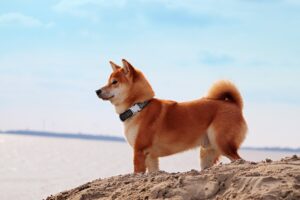
Shiba Inu
Shiba are small to medium-sized dogs recognized for their foxy appearance and hypoallergenic coat. They have a double coat that sheds annually, although they require less maintenance in comparison to other breeds. Shiba Inus are lively, independent dogs who make devoted friends for experienced dog owners who recognize their distinct disposition.
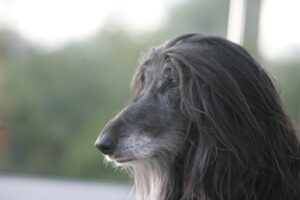
Afghan Hound
The Afghan hound has a long, silky coat and is a larger, hypoallergenic breed. While their coat is hypoallergenic, it requires frequent care to keep its beauty and prevent matting. Afghan hounds are big hypoallergenic dogs that are graceful and regal and noted for their independence. They are appropriate for individuals or families who can devote time to their grooming needs and provide adequate exercise.
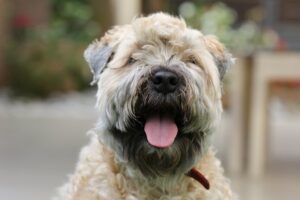
Wheaten Terrier
The smooth-coated Wheaten Terrier is a hypoallergenic medium-sized breed with a smooth, silky coat. They have a warm, affectionate personality and adapt well to a variety of living situations. Wheaten Terriers must be groomed on a regular basis to keep their coat in good shape and to prevent matting.
These are only a few of the most popular hypoallergenic dog breeds. Individual dogs, even within the top hypoallergenic dogs, can still create allergens to some degree, so before making a final selection, spend time with specific dogs or puppies to measure your allergic reactions.
It’s worth noting that hypoallergenic mixed-breed dogs or hybrid breeds like Goldendoodles (a Golden Retriever and Poodle mix) or Labradoodles (a Labrador Retriever and Poodle mix) are sometimes sold. However, the hypoallergenic quality of these crosses might vary; therefore, specific testing or contact is required to establish their compatibility for allergy sufferers.
Finally, picking the best hypoallergenic dog breed requires taking into account a variety of criteria such as size, temperament, grooming requirements, and compatibility with your lifestyle and allergies.
Allergic Reactions in the Presence of Dogs
Living with allergies does not preclude you from enjoying the companionship of a dog. You can minimize allergen exposure and the risk of allergic reactions by using the correct allergy control practices. Here are some suggestions for dealing with allergies in the company of dogs:
Maintaining an Allergen Free Living Environment
Cleaning your living area on a regular basis is critical for reducing allergens. Vacuuming carpets, rugs, and furniture can aid in the removal of allergens that have accumulated on surfaces. Use a vacuum cleaner with a HEPA filter, which is designed to effectively collect tiny particles such as pet dander. To eliminate allergies, hard floors should be cleaned or mopped on a regular basis.
Damp dusting surfaces can help catch and eliminate allergens more efficiently than dry dusting. Pay close attention to allergen prone locations such as shelves, window sills, and baseboards. It’s also a good idea to wash bedding, particularly pet bedding, in hot water on a regular basis to prevent allergies.
Using hypoallergenic bedding and covers can help reduce allergy exposure in the bedroom even further. These items are intended to repel allergens and keep them from penetrating pillows and mattresses.
Regular Bathing and Grooming
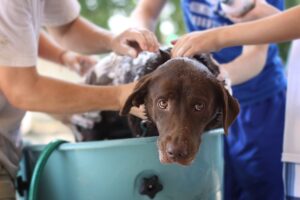
Grooming your dog on a regular basis is essential for reducing shedding and dander production. Brushing your dog’s coat on a regular basis helps eliminate loose hair and dander and keeps them from spreading throughout the house. Delegate grooming responsibilities to someone who is allergy-free. If that isn’t an option, try hiring a professional groomer to limit your direct contact with allergies during grooming sessions.
Bathing your dog on a regular basis can also aid in the reduction of allergies in their coat. Regular shampoos may cause skin irritation in certain dogs, so use a hypoallergenic shampoo prescribed by your veterinarian. After bathing, properly dry your dog to minimize moisture buildup, which can contribute to the growth of allergies such as mildew.
Making Use of HEPA Filters and Air Purifiers
High-efficiency particulate air (HEPA) filters and air purifiers can successfully eliminate airborne allergens from your house, including pet dander. Place these devices strategically throughout the house, particularly in locations where your dog spends the most of his time. To filter allergens from the entire home, HEPA filters can be placed in HVAC systems. HEPA air purifiers are especially effective in bedrooms for creating a clean, allergen-free sleeping environment.
Remember to clean or change the filters in your air purifiers on a regular basis to keep them functional. Maintenance instructions will be provided by the manufacturer.
Medications and Immunizations
Antihistamines sold over-the-counter can assist with moderate allergy symptoms, including sneezing and itching. Consult your healthcare professional or allergist to identify the best antihistamine for you. If your symptoms are severe, they may potentially prescribe stronger drugs.
Individuals with moderate to severe allergies may benefit from allergy shots, often known as immunotherapy. Allergy shots entail steadily increasing dosages of specific allergens over time in order to build tolerance and lessen allergic responses. To establish its suitability and effectiveness for your specific allergies, consult with a healthcare practitioner or allergist.
Immunotherapy and Desensitization
Immunotherapy is a long-term therapeutic option that can bring relief to allergy sufferers. It entails receiving allergen injections on a regular basis in order to desensitize the immune system. The body becomes less receptive to allergens with time, resulting in fewer allergy symptoms.
Immunotherapy is typically advised for people who have severe allergies or who do not respond well to other therapies. Consult an allergist to see if immunotherapy is a good option for you.
Personal hygiene and avoidance of allergens.
Good personal cleanliness can help reduce allergy exposure. Hand washing after stroking or handling your dog might help eliminate allergies from your skin. While engaging with your dog, avoid touching your face or rubbing your eyes, since this can transfer allergens to sensitive areas.
It’s also a good idea to make some areas of the house, such as bedrooms or locations where you spend a lot of time, pet-free zones. This can help you create a safe haven away from allergens and limit exposure while sleeping or relaxing.
Furthermore, donning a dust mask or using a nasal rinse can provide brief relief by minimizing allergen inhalation.
Remember to seek individualized advice and guidance on managing your specific allergies in the company of dogs from a healthcare expert or allergist. They can make recommendations targeted at your specific needs and assist you in developing effective allergy treatment techniques.
FAQs
Are hypoallergenic dogs fully allergic-free?
No, hypoallergenic dogs create less allergens but cannot completely eradicate allergies.
What causes dog allergic reactions?
Proteins found in dog dander, saliva, and urine are the most common allergens.
What are some of the most prevalent symptoms of dog dander allergies?
Sneezing, nasal congestion, itchy/watery eyes, skin rashes, coughing/wheezing, chest tightness, exhaustion, headaches, and sleep problems are some of the symptoms.
Does hypoallergenic dog dander shed less?
Although hypoallergenic breeds have hair-like coats that shed less dander, they nonetheless produce allergic particles.
What factors should be taken into account while selecting a hypoallergenic dog?
Consider your allergen sensitivity, grooming needs, physical activity/space requirements, and compatibility with the personality of the breed.
How do I deal with allergies when I live with a hypoallergenic dog?
Adopt allergen avoidance techniques, exercise proper grooming and hygiene, keep your living environment clean, and seek medical attention if necessary.
Can allergy testing aid in the selection of a hypoallergenic breed?
Yes, allergy testing can reveal particular allergens and help you select a hypoallergenic breed that is appropriate for your sensitivities.
Which hypoallergenic dog breeds are well-known?
Bichon Frise, Poodle, Maltese, Portuguese Water Dog, Schnauzer, Yorkshire Terrier, Shih Tzu, Basenji, West Highland White Terrier, and Cairn Terrier are some of the breeds that are well known.
Is there a breed of tiny hypoallergenic dogs?
Yes, small hypoallergenic breeds such as the Bichon Frise, Poodle, Maltese, Yorkshire Terrier, Shih Tzu, West Highland White Terrier, and Cairn Terrier are available.
Can hypoallergenic mixed-breed or hybrid dogs exist?
Mixed-breed dogs or hybrids can be hypoallergenic, however it depends on the genetic makeup of the individual dog.
Conclusion
Finally, hypoallergenic dog breeds may be a good alternative for allergy sufferers looking for a canine friend. While no dog breed is fully allergy-free, hypoallergenic breeds create fewer allergenic particles, lowering the likelihood of allergic reactions. Individuals can make an informed decision that corresponds with their lifestyle and allergy management needs by knowing the origins and symptoms of allergies, disputing popular myths, and evaluating essential considerations before choosing a hypoallergenic dog. Individuals with allergies can enjoy the love and company of a hypoallergenic dog while limiting the impact of allergens on their health by using proper allergy management strategies, regular grooming, and lifestyle changes.



